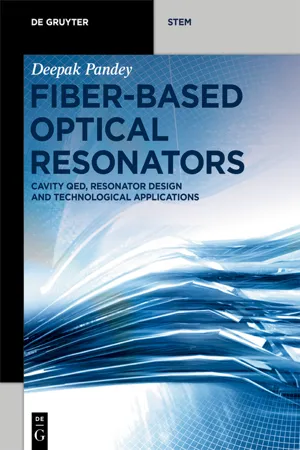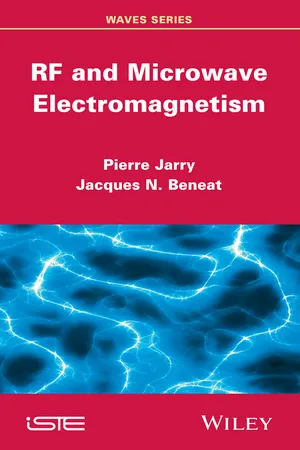Physics
TEM Mode
TEM mode refers to the transverse electromagnetic mode, which is a type of electromagnetic wave propagation in a waveguide. In this mode, both the electric and magnetic fields are transverse to the direction of wave propagation. It is characterized by a single transverse electric field component and a single transverse magnetic field component.
Written by Perlego with AI-assistance
Related key terms
Related key terms
1 of 4
Related key terms
1 of 3
4 Key excerpts on "TEM Mode"
- eBook - ePub
Fiber-Based Optical Resonators
Cavity QED, Resonator Design and Technological Applications
- Deepak Pandey(Author)
- 2024(Publication Date)
- De Gruyter(Publisher)
A waveguide is a structure or device used to guide and confine electromagnetic waves along a specific path. It is designed to propagate and control the transmission of electromagnetic energy, typically in the form of microwaves or radio waves. Waveguides are commonly used in various fields, including telecommunications, radar systems, microwave engineering, and high-frequency applications. Waveguides are typically constructed as hollow metallic or dielectric tubes, although other shapes and materials can be used depending on the specific requirements. The inner walls of the waveguide are highly reflective to the electromagnetic waves, allowing them to bounce back and forth within the waveguide without significant energy loss. This reflection is often achieved through the principle of total internal reflection, where the waveguide walls act as mirrors for the waves. The main purpose of a waveguide is to provide a controlled pathway for electromagnetic waves, allowing them to be efficiently transmitted, directed, and manipulated. By confining the waves within the waveguide, they can be guided over long distances while minimizing losses due to radiation and external interference. Waveguides support the propagation of different modes, which represent distinct patterns of electric and magnetic fields within the structure. These modes depend on the geometry, dimensions, and boundary conditions of the waveguide. The selection of a specific mode depends on the desired performance and functionality of the waveguide system.Waveguide modes refer to the different possible patterns of electromagnetic wave propagation within a waveguide. The modes of a waveguide are distinct patterns of electric and magnetic fields that can exist within the waveguide. These modes are characterized by their unique field distributions and corresponding propagation characteristics. The number and types of modes depend on the geometry and dimensions of the waveguide. Here are some key concepts related to waveguide modes.TE-modes are electromagnetic wave modes in which the electric field is purely transverse (perpendicular) to the direction of propagation. In these modes, the magnetic field has both transverse and longitudinal components. The subscript “m,n” is used to represent the mode indices, where “m” denotes the number of half-wavelength variations of the electric field across the width of the waveguide, and “n” represents the number of half-wavelength variations along the length.TM-modes are electromagnetic wave modes in which the magnetic field is purely transverse to the direction of propagation. In these modes, the electric field has both transverse and longitudinal components. Similar to TE modes, the mode indices “m,n” are used to represent the variations of the magnetic field across the width and length of the waveguide.Hybrid modes, also known as TE-TM modes or EH-modes, have both electric and magnetic field components in both transverse and longitudinal directions. These modes possess characteristics of both TE and TM modes and are generally more complex in nature. - eBook - ePub
- Philip C. Magnusson, Andreas Weisshaar, Vijai K. Tripathi, Gerald C. Alexander(Authors)
- 2017(Publication Date)
- CRC Press(Publisher)
For the sake of mathematical simplicity, a particular traveling-wave mode for the waveguide with a rectangular cross section will be studied first. The same general technique employed for the coaxial cable, that of postulating a solution and testing it by substituting in Maxwell's equations, will be used initially. Afterward a more general mathematical approach will be tried. Figure 13-1 shows the geometry of the rectangular waveguide.FIGURE 13-1 Dimensions and coordinates for rectangular waveguide.13-1 TEm 0Propagating ModesThe simplest and also the most commonly used mode in a rectangular waveguide has these properties: (1) the electric field is confined to planes perpendicular to the direction of propagation, whereas the magnetic field has both transverse and longitudinal components, and (2) the electric field is directed from one of the guide surfaces straight across to the opposite surface. Actually an infinite number of modes possess these properties in common; they are referred to as TEm 0modes by which the following is meant: (1) TE designates transverse electric (property 1 above), (2) the second subscript, 0, indicates an absence of variation in field configuration as a function of the shorter transverse direction (y direction in Fig. 13-1 ), and (3) the first subscript, m, which is an integer, designates the particular mode of this class. This third item will be described specifically in Sec. 13-la(2), after the TEm 0field patterns have been derived.a. Electric and Magnetic Fields
For the ordinarily used approximation of the electric and magnetic fields, the waveguide walls may be assumed to be of infinite conductivity, in which case a traveling wave should propagate without attenuation.(1) Traveling-Wave Solution
In view of the success experienced in finding traveling-wave solutions in unbounded space and in a coaxial cable, such a solution will be postulated here. The phase function β will be regarded as an unknown and may well differ from that for the TEM Mode. In accordance with the properties just listed for the TEm 0mode, the E field will be assumed to consist solely of a y -directed component,Ey. However, because the component of E tangential to a perfectly conducting surface must vanish (Sec. 11-2b) and, as shown in Fig. 13-1 , such surfaces exist at x = 0 and atx —a, Eywill be assumed to be a function of x. The requirement that the divergence of D should vanish (Eq. 10-19 , with p = 0) will be met if the E thus chosen is not a function of y - eBook - ePub
- Pierre Jarry, Jacques N. Beneat(Authors)
- 2014(Publication Date)
- Wiley-ISTE(Publisher)
θ .We will see that the attenuation of the TE 01 is zero at high frequencies (60–100 GHz) and that is why these are used to simultaneously transport a lot of communications (500,000 or more).7.7.5.
TM11 Degenerated mode with the TE017.8. Power flux and attenuations
We give without demonstration the results of the two power fluxes (In fact, the demonstrations use the waves given in [7.3].TEmnandTMmn) and the two attenuations (TEmnandTMmn).In the two cases (power flux and attenuation), the expressions of theTMmnare simpler but the fundamental is aTEmnmode.We can also note that the behavior of the attenuation of theTEmnwhen we have large values of the frequency (ω → ∞) is of the form:where a 1 and a 2 are two constants.– If m ≠ 0, the behavior of α TEmn isαTEmn≈ and the attenuation grows as .– If m = 0, the behavior of αTB 0nis and the attenuation decreases as . This is an important property of the TE0nand they are used at high frequencies to transport a lot of communications.7.9. Problems
7.9.1. Semi-circular and quadrantal guide
From the spectrum (TE and TM ) of the circular guide, find the modes that propagate:1) in the semi-circular guide; 2) in the quadrantal guide.Do not forget that in the circular guide theTEmnand theTMmncan have two polarizations. Then the variation versus θ - Graciela Wild Padua, Qin Wang(Authors)
- 2012(Publication Date)
- Wiley-Blackwell(Publisher)
7 Transmission electron microscopyChanghui LeiAbstract: Electrons accelerated to a few hundred kilovolts will produce many signals when interacting with a thin specimen. A transmission electron microscope (TEM) can detect and analyze these signals to obtain images, diffractions and different spectra from an area of hundreds down to a few nanometers at atomic resolution. The images and diffractions can be obtained through a conventional TEM Mode, where a parallel electron beam illuminates the interested area, or through a scanning TEM (STEM) mode, where a focused beam is scanned across the specimen. Two important signals used for chemical analysis are the characteristic X-ray and energy-loss electrons. STEM has good spatial resolution, which makes the microscope and its attached spectrometers a powerful instrument in investigating the structure and chemistry of nanomaterials.Keywords: transmission electron microscopy; TEM; scanning transmission electron microscopy; STEM; energy-dispersive spectrometer; EDS; electron energy-loss spectrometry; EELS; image; diffraction pattern; nanomaterial; composition analysis7.1 BackgroundIt is well known that accelerated electrons have wave–particle duality. Transmission electron microscopy (TEM) is a very good example of the application of this duality. The wave property enables an electromagnetic lens to focus the accelerated electrons; consequently, the accelerated electrons can act as a source to image materials. TEM applies an electron beam to interact with and transmit through an ultra-thin specimen, and forms an electronically magnified image of the specimen via electromagnetic lenses for detailed observation. There are a variety of types of imaging techniques, generally based on two main classes of microscopy technique. Conventional TEM (CTEM), the original form of TEM, illuminates a stationary beam on an electron-transparent specimen. The beam can be either parallel or convergent. When the electron beam emerges from the specimen, it carries information about the specimen and forms an image via the objective lens of the microscope. CTEM is based on an image formation process that is conceptually analogue to the process in classical light microscopes. The resolution is determined by the wavelength of the accelerated electrons and the quality of the imaging optics behind the specimen. Another type of TEM is scanning TEM (STEM), where a focused electron probe is scanned across an electron-transparent specimen that allows the selection and detection of transmitted electrons. The signal is amplified and used to modulate the intensity of images, usually displayed on a cathode-ray tube (CRT) that is scanned synchronously with the electron probe. STEM is essentially a “mapping” technique whose resolution is mainly determined by the probe size – that is, by the formation optics of the electron probe before the specimen. The geometric magnification is determined by the ratio of the area displayed on the image unit to the area synchronously scanned by the electron probe on the specimen.
Index pages curate the most relevant extracts from our library of academic textbooks. They’ve been created using an in-house natural language model (NLM), each adding context and meaning to key research topics.
Explore more topic indexes
Explore more topic indexes
1 of 6
Explore more topic indexes
1 of 4



